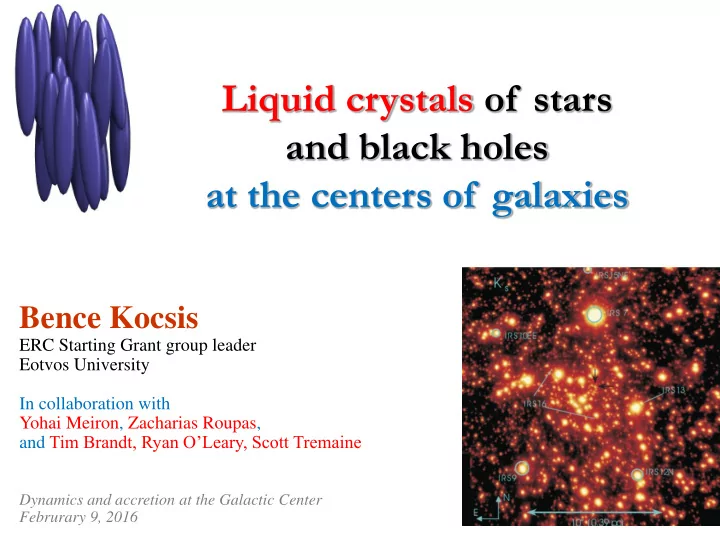

Liquid crystals of stars and black holes at the centers of galaxies Bence Kocsis ERC Starting Grant group leader Eotvos University In collaboration with Yohai Meiron, Zacharias Roupas, and Tim Brandt, Ryan O’Leary, Scott Tremaine Dynamics and accretion at the Galactic Center Februrary 9, 2016
Dynamical Formation Signatures of black hole binaries in future gravitational wave detections Advanced LIGO will measure GWs soon! • dynamical encounters lead to black hole mergers • higher mass objects merge more often by M^4 • GW detections can tell us about the BH IMF Monte Carlo and Nbody simulations O’Leary, Meiron, & Kocsis (2016 – arXiv tonight)
Evidence for disrupted globular clusters? A fraction of stars was delivered by infalling globular clusters Fermi measured excess gamma ray emission from the Galactic bulge • Millisecond pulsars match the observed spectrum • Millisecond pulsars do not form in the bulge • Infalling globular clusters delivered the needed population (No need to invoke dark matter annihilation to explain the gamma ray excess, just ordinary MSPs) Brandt & Kocsis (2015)
Liquid crystals of stars to explain Anisotropy of massive stars Yelda+ 2014 Middle 0.13-0.27 pc Inside 0.03-0.13 pc Outside 0.27-0.47 pc Density map of angular momentum vector directions for massive stars at three different locations
Liquid crystals of stars to explain Anisotropy of massive stars Bartko+ 2009 Cos[ polar angle ] azimuthal angle azimuthal angle azimuthal angle Middle 0.13-0.27 pc Inside 0.03-0.13 pc Outside 0.27-0.47 pc Density map of angular momentum vector directions for massive stars at three different locations
Liquid crystals of stars at the centers of galaxies orbital period << in-plane precession << reorientation << semimajor axis change [1 — 10 4 yr ] [10 5 – 7 yr] [10 4 — 5 yr] [10 9 yr] Persistent (“resonant”) torques between smeared orbits cause rapid reorientation (Rauch & Tremaine 1996, Hopman & Alexander 2006, Eilon, Kupi, Alexander 2009, ...) Hamiltonian of resonant relaxation Kocsis & Tremaine 2014 • Multipole expansion • Leading order is the Hamiltonian of a liquid crystal Interesting analogy: Liquid crystals
Results Mean field theory Monte Carlo Markov Chain RMS inclination [deg] Cos[ inclination ] distance from center [arcsec] Log[ distance from center / 4 arcsec ] Time evolution c.f: the observed distribution Cos[ inclination ] Log[ distance from center ]
Statistical equilibria Cos 2 [ inclination ] Distribtion of angular momentum directions: Cos[ inclination ] -20 C / -4 F -10 C / 14 F 0 C / 32 F 0 C / 32 F 5 C / 41 F
Summary • LIGO will constrain the high-mass end of the BH mass function in dense star clusters • Fermi detected remains of disrupted globular clusters • Orbital planes of stars reorient resonantly (~Myr) – Liquid crystals have a similar Hamiltonian – First order phase transition mixed phase (disk + spherical) – Young stars in the Galactic center show a similar structure • Use this to – model the inclination distribution of different stellar types – predict the distribution of black holes
Hierarchy of Interaction Timescales vs. radius Semimajor axis change Eccentricity change Time scale Disk age Re-orientiation of orbital plane Precession in plane Keplerian orbit around SMBH Kocsis & Tremaine (2011)
Final state in the simulation • Three snapshots in two simulations Heavy objects in a disk Heavy objects spherical Initially: Light objects spherical Light objects in a disk T=0 T=0 Cos[ inclination] T=500 T=500 T=1500 T=1000 Log(semimajor axis) Log(semimajor axis)
Statistical equilibrium • Objects fill up phase space uniformly tot E const Find maximum entropy configuration under constraints tot L const E ( L ) f ( L ) C exp kT Phase transition in inclination • Mean field theory • Maier & Saupe (1959) • keep only the quadrupole term • assume interaction dominated by stars on same radius • self-consistency equation for quadrupole moment
Thermal equilibrium (maximum entropy) orbit normals as a function of radius outer radius inner radius • initially warped disk • Stars: • same mass, eccentricity • conserve total energy “ microcanonical ensemble” Phase transition in inclination Monte Carlo Markov Chain simulation
Nuclear Star Clusters The densest stellar environments Multiple stellar populations Walcher + ‘06, Rossa + ‘06, Seth+ 06, 08, 10 • old, red spheroid • young, blue disk • Both rotate • In many edge-on galaxies: counterrotating with respect to galaxy
Recommend
More recommend